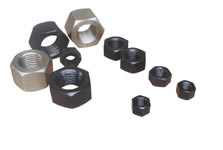Nuts Introduction
A nut is a small hexagonal object made out of metal. It is shaped in a hexagon so that it is easy and firm to grip from all sides. It has a hole in its centre, which has a thread running around it.

A thread is a spiral cut groove. It is used as a fastener to a matching bolt. The bolt and the nut are kept together by a combination of their threads’ friction. Nuts come in various types, including hex, cap, coupler, wing, turnbuckle and lock.
the threads in nut shall be matching with the threads in the HSFG (High Strength Friction Grip) bolt and the nut shall be free running on the threads of the HSFG bolts.
1. Property Class: Nuts are designated by property class designation, which is equal to 1/100 of the minimum tensile strength in Newton per square mm of the bolt. For HSFG bolts, the property classes to be used are 8, and 10 as specified in IS 1367 , suitable for bolts of property class 8.8 and 10.9 respectively. The nuts shall be hardened and then tempered at a temperature of at least 4250 C.7 Normal height of nut shall be more than 0.8 times the nominal bolt diameter.
2. Identification of Nut:
a) Manufacturer’s identification symbol
b) Property class, marked as ‘8S’ or ‘10S’. (The suffix ‘S’ denotes a high strength structural nut with a large series hexagon.) Alternately, ‘8.8 S’ or ‘10.9 S’ are also acceptable.
3. Surface of Nut: All nuts shall be supplied with coating consisting of zinc phosphate that is used in conjunction with suitable oil of rust preventive type
